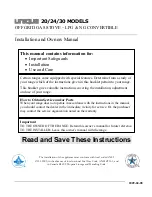
18
JINECI05 Rev. E. 11/11/2014
Only wire-centred sweeps’ brushes fitted with a
guide wheel should be used. If it is not possible to
sweep all parts of the chimney through the
appliance, ensure there is adequate access to
cleaning doors. If the stove is fitted in place of an
open fire, then the chimney should be swept one
month after installation to clear any soot falls
which may have occurred due to the difference in
combustion between the stove and the open fire.
S
EASONAL USE
If the appliance has been unused for a long period
of time, such as during the spring and summer
months, the chimney should be checked for
potential obstructions by a competent person
before lighting the stove.
D
E
-A
SHING
De-ashing should be carried out on a regular basis
to avoid a buildup of ash and ensure sufficient
primary air flow. Empty the ashpan regularly to
prevent ash reaching the underside of the great
bars.
A
NNUAL
S
ERVICE
Eco-ideal Stoves recommend that this appliance is
serviced annually, preferably prior to the start of
the heating season, thus avoiding any delay in
receiving replacement components, should you
need them. I you feel unable to undertake this
task, Eco-ideal Stoves recommend that you
contact the installation engineer for advice.
Remove all the internal components:
Riddling Bars, Cam Bar, Catch Bar, Ashpan, Side
Plates and Baffle.
Clean them with a wire brush and inspect them
for damage.
Sweep the chimney/flue system if necessary.
Clean down the internal surfaces of the appliance
using a scraper or wire brush.
Inspect these surfaces for damage/corrosion.
If corrosion or damage is found we advise that you
consult with your installer about
rectification/repair.
Brush out or vacuum the inside of the appliance
and re-fit the internal components.
Inspect the Glass and Gasket. Clean the Glass with
a non-abrasive cleaner if required. If the Gasket is
torn or damaged we recommend that is replaced
to ensure that no products of combustion enters
the room when the appliance is used.
Brush down the outer surface and touch up the
paint if necessary. Burn the appliance at a low
rate, after maintenance, to allow any new seals,
paint or glue cure properly. The appliance may
emit unpleasant odours during this process,
please ensure the room is well ventilated.
T
ROUBLESHOOTING
:
Incorrect Flue Draught in your chimney/flue
system will cause for poor performance of your
appliance.
Excessive Flue Draught can cause Poor burning
control, excessive fuel consumption and even
noise from the Air Controls.
Low Flue Draught can cause difficulty in lighting
and running the appliance, poor heat output and
smoke entering the room when the Appliance
Door is opened.
Poor quality Solid Mineral Fuel and/or damp wood
will also affect the performance of your appliance.
Please be aware of the possible warning signs that
your appliance is not functioning correctly.
Poor combustion, staining or sooting around the
appliance, condensation or dampness on walls or
windows in the room where the appliance is
fitted, a strange smell when the appliance is lit or
water leaking from the appliance.
Please consult with your installer if you are
concerned in any way about the performance of
this appliance.
T
ROUBLESHOOTING EXAMPLES
:
F
IRE WILL NOT BURN
Check that:
1.
The air inlet is not obstructed in any way.
2.
Chimneys and flue ways are clear.
3.
A suitable fuel is being used.
4.
There is an adequate air supply into the
room.
5.
An extractor fan is not fitted in the same
room as the stove.
6.
Flue draught is above minimum level (see
installation instructions).
F
IRE
B
LAZING OUT OF CONTROL
Check that:
1.
The doors are tightly closed.
2.
The air controls are all in the closed
position.
3.
A suitable fuel is being used.
4.
The glass retaining clips are not loose.
5.
The door rope seals are in good condition
6.
Flue draught is below maximum level (see
installation instructions).
Содержание CVSECI05FM
Страница 24: ...24 JINECI05 Rev E 11 11 2014...







































